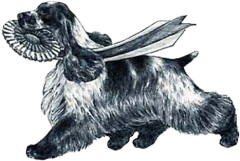Adult Onset Neuropathy (AN/AON)
last updated 25/10/2024
Adult Onset Neuropathy (AON) sometimes referred to as AN, is an inherited neurological disorder characterised by a weakness in the hind limbs, eventually leading to weakness in the front limbs. Neurological signs of this condition seem to progress gradually over three to four years.
Adult onset neuropathy affects the dog’s nerve pathways and responses. Clinical symptoms of AN first start between the age of 7.5 and 9 years. The symptoms are; weakening, tremors, unsteady hind limbs and uncoordinated movement, as well as problems getting up and down, climbing and jumping. The stance in the hind limbs is wide-base and the hocks will drop lower to the ground.
The weakness eventually progresses to also involve the front limbs. When dogs become non-ambulatory in all limbs, difficulty in swallowing also becomes apparent. It compromise the dog’s ability to as move around as well eat and drink normally.
The condition seem to progress gradually over three to four years.
Adult onset neuropathy cannot be treated or cured, and management of the condition in affected dogs is usually supportive and palliative. Ultimately, a decision is usually made to euthanise affected dogs once their quality of life becomes affected to a significant degree, in order to prevent prolonged suffering.
Adult onset means that affected dogs may have been used for breeding prior to diagnosis.
Reliable genetic testing for determining breeding strategies is important so the gene diversity is retained and a depressed gene pool does not create other problems within the breed
Due to late onset genetic testing should be performed before breeding. At least one parent should be confirmed clear of the mutation in order to eliminate this from breeding lines and to avoid the potential of producing affected puppies.
Cocker with AON
AON Articles
AON Around The World
Genetic testing has proven to be a invaluable tool and an intrinsic part of breeding healthy cockers and reducing the likelihood of disease.
informal data collected from OFA, RKC & CSDB
Other databases had insufficient validation of data to be included
Data lasted updated Dec 2023
% are more important when considering these statistics rather than the numbers recorded above, as some dogs results may have been duplicated in different databases
Research Notes AN/AON
My thoughts on developing minimum breed standard testing. As AN can be scientifically determined using DNA, this should form part of any required testing programme
* Don't Confuse with DM.
AON has similar clinical symptoms to Degenerative Myelopathy (DM) but DM causes an earlier and more rapid deterioration. The University of Missouri Animal Molecular Genetic Lab. found that all Cocker Spaniels clinically affected with AON have tested clear for the mutation that underlies DM. So there is no known links between the 2 conditions at this time.
